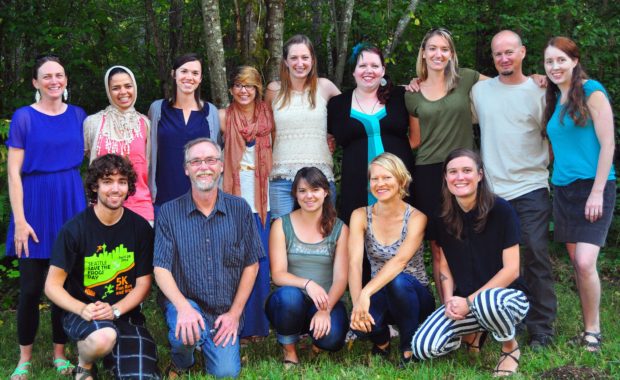Text by Jeanne Dodds, SPP Prairie Conservation Nursery Coordinator for Washington Corrections Center for Women
Photos by Ricky Osborne
In May, Sustainability in Prisons Project (SPP) created a first-time educational experience for the prairie conservation nursery team at Washington Corrections Center for Women (WCCW). While Washington State Department of Corrections (WA Corrections) staff have had other chances to visit prairie sites, it was the first time that inmate technicians were able see for themselves the rare landscape they help restore. The WCCW team toured two partner sites, the Center for Natural Lands Management’s Violet Prairie Seed Farm, and restored prairie at Wolf Haven International. Each of these sites receives plants produced at WCCW.

At Violet Prairie Seed Farm, Prairie Nursery Technician Samantha Morgan found out that mature Balsamorhiza deltoidea flowers smell like chocolate! Photo by Ricky Osborne.
We toured the Wolf Haven restoration site with plant conservation specialists. We observed recovering populations of golden paintbrush (Castilleja levisecta), one of the endangered plants cultivated by the technicians at WCCW, and a species critical to Taylor’s Checkerspot Butterfly recovery. At Violet Prairie Seed Farm, the farm manager and work crew members presented some of the techniques and skills necessary to produce native seed on a large scale.
These site visits provided context and information to enhance the work of the technicians in the Conservation Nursery, and also adds education, training, and connections for their futures.

Conservation Nursery Technician Ashley McElhenie, Conservation Nursery Manager Carl Elliott, and Conservation Nursery Technician Samantha Morgan discuss growing Lomatium triternatum. Photo by Ricky Osborne.
 Conservation Nursery Technician Ashley McElhenie uses a hand lens to examine a Lomatium species at Violet Prairie Seed Farm. Photo by Ricky Osborne. |
 Conservation Nursery Manager Carl Elliott with rows of Balsamorhiza deltoidea, one of the primary plant species grown at WCCW. Photo by Carl Elliott. |

Conservation Nursery Technician Samantha Morgan and Conservation Nursery Coordinator/Graduate Research Assistant Jeanne Dodds in the fields of Plectritis congesta at Violet Prairie Seed Farm. The site visits were the technicians’ first opportunity to see the species they grow as mature plants. Photo by Ricky Osborne.

Now at Wolf Haven International, Conservation Nursery Technician Ambrosia Riche looks closely at Armeira maritima in full bloom in the wild. Photo by Ricky Osborne.

A native sweat bee on Armeria species; as a part of the Conservation Nursery educational program, technicians learn about the importance of native pollinators in prairie ecosystems. Photo by Ricky Osborne.

Another species grown extensively at WCCW, Castilleja hispida blooms vibrantly in the prairies at Wolf Haven International. Photo by Ricky Osborne.

Wolf Haven International Conservation Specialist Anne Schuster, Conservation Nursery Technicians Ashley McElhenie, Ambrosia Riche, Samantha Morgan, and Conservation Nursery Manager Carl Elliott discuss Mima mound prairie topography. Photo by Ricky Osborne.

Conservation Nursery Technician Samantha Morgan, Conservation Nursery Coordinator/Graduate Research Assistant Jeanne Dodds, and Wolf Haven International Conservation Specialist Anne Schuster identify native prairie plants. Photo by Ricky Osborne.

Corrections Officer Kyra Cammarata and Conservation Nursery Technicians Ambrosia Riche and Ashley McElhenie sample edible Miner’s lettuce (Claytonia perfoliata). Photo by Ricky Osborne.

Thanks in part to SPP’s conservation programs, Castilleja levisecta has returned to the prairies at Wolf Haven International. Photo by Ricky Osborne.

Conservation Nursery Technicians Samantha Morgan, Ambrosia Riche, and Ashley McElhenie identify prairie plant species with Conservation Nursery Manager Carl Elliott at Wolf Haven International. Photo by Ricky Osborne.

A visit from a beautiful wolf, named Myta Jr., during our tour of Wolf Haven International. Photo by Ricky Osborne.

The path to the Grandfather Tree at Wolf Haven International with Conservation Nursery Manager Carl Elliott in the background. Photo by Ricky Osborne.

Grandfather Tree at Wolf Haven International. Photo by Ricky Osborne.

Conservation Nursery Technicians Samantha Morgan, Ambrosia Riche, and Ashley McElhenie and WCCW Conservation Nursery Liaison Scott Skaggs with the massive branches of the Grandfather Tree at Wolf Haven International. Photo by Ricky Osborne.
















 Graduation brings an end to student-staff employment. Each coordinator trains their successor, which is as much about introducing them to the culture and ways of thinking as it is about program policy and protocols. Each turnover is bittersweet. We have to say good-bye to someone we have relied on and invested in, and it is painful to see them go.! At the same time, we get to welcome someone new, and their fresh perspectives helps SPP to continually improve; we can’t get stale! Also, there is the satisfaction of seeing SPP alumni go on to new and valuable endeavors, and we take pride in supporting their ongoing careers and aspirations.
Graduation brings an end to student-staff employment. Each coordinator trains their successor, which is as much about introducing them to the culture and ways of thinking as it is about program policy and protocols. Each turnover is bittersweet. We have to say good-bye to someone we have relied on and invested in, and it is painful to see them go.! At the same time, we get to welcome someone new, and their fresh perspectives helps SPP to continually improve; we can’t get stale! Also, there is the satisfaction of seeing SPP alumni go on to new and valuable endeavors, and we take pride in supporting their ongoing careers and aspirations.
 by Kristina Faires, SPP Program Enhancement Coordinator
by Kristina Faires, SPP Program Enhancement Coordinator





















